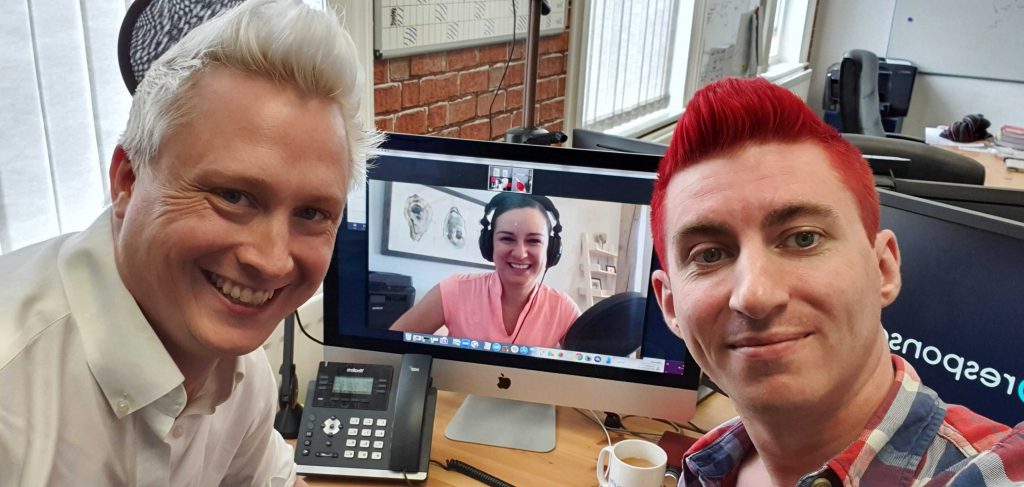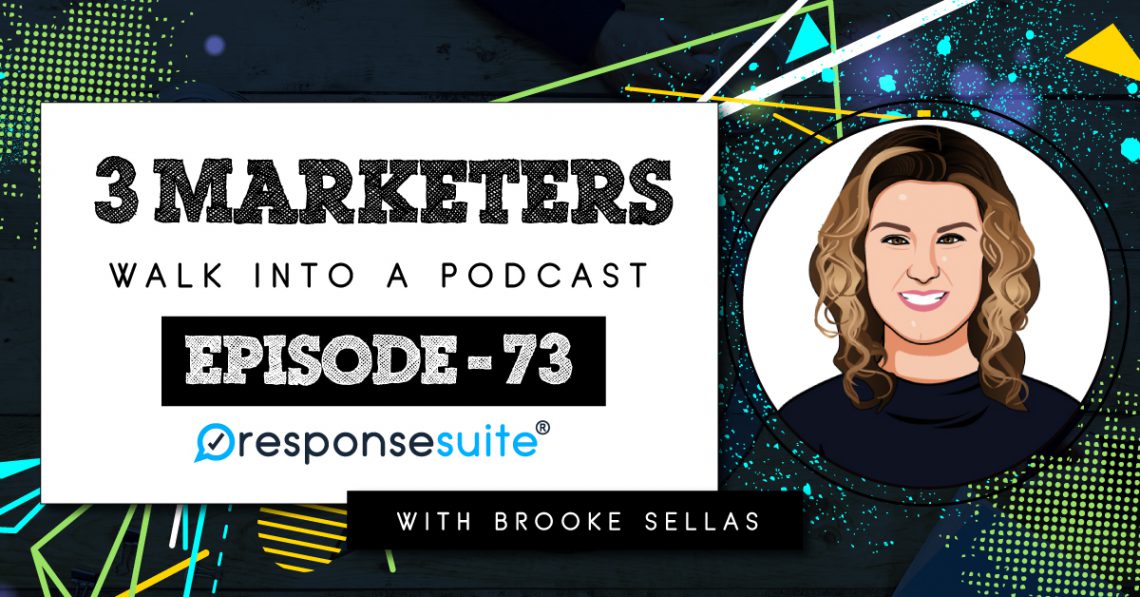Dealing with customer care and customer complaints (we all get them) is an important part of any business, but it can be tricky to know the best way to handle it.
Brooke Sellas is here to discuss how customer care has shifted into the ‘Twitter generation' and how we can make the most of social listening to give our customers a better experience when dealing with queries and complaints.
Over to you Brooke…
Subscribe now on your favourite podcast player:

You help amazing businesses to do better customer support and customer care. Let’s talk about how that’s changed?
- Younger generations are not going to really call your support line and sit and listen to your cheesy music while they wait for an answer. They are not going to email your support team.
- What they are doing is going to social, they are more apt to complain, and they want an answer immediately and to let everyone in their social sphere know they are upset with you.
When we say the younger generation, who are we talking about?
- 18 to 25. Millennials could also be included in that group.
- It’s a widespread age group. Going from 18 to even mid-thirties.
- I’ve seen older people go to complain as well
- If an airline is delayed, someone’s package gets messed up by amazon, where did they go to make that complaint. Most of the time it’s Twitter.
Twitter does seem like a place where people go to complain, is that true?
- It is definitely a place where people go to complain. Twitter seems more instantaneous then Facebook or Instagram or even Linked In. Usually, the response rate on Twitter seems to be much more conversational, much more back and forth and it happens much faster, so I feel like that’s the go-to place.
- But complaints come from all over the place and depends on how the brand is represented as well as which channel they are most represented on. That’s where most of their complaints will happen.
When looking across all of our channels and thinking about maybe shifting away from traditional support, how do we start to decide which channels we start doing our support through? Do we always have to meet them where they are or do you think we should sort of direct that?
- Meet them where they are. It’s a master undertaking to try and get a crowd of people who aren’t really connected in any other way other than through your brand and move them somewhere else.
- Use social listening. Sprout Social is a tool that provides us with social listening. Their reports can help us to understand where the most conversation is happening, where all the sentiment is happening, and what kind of sentiments are happening.
- You can even drill down to see what they are complaining about the most.
Do you typically recommend having a separate social channel to handle the support? Do you try and move people away from your normal one and over to this special once or do you just use the same channel?
- It depends on the client. We are helping a lot of clients in retail, consumer goods, finance. It depends on their key performance indicators and goal and what they are looking to achieve.
- Some, it is a totally separate channel and with others, it only happens in one place.
- We don’t try and make that decision for the client. We can help guide them, but there is no real difference having it on one channel versus the other.
- You're still getting the negative sentiment around your brand and your products if there is a negative sentiment.
- I don’t think there is a benefit to moving it to different channels unless you have different teams set up to handle just the support channel and then just the brand channel.
What’s the new process going to look like? What does that new flow look like?
- We build out custom response workflows. For every client, it’s different depending on their goals and what they are trying to achieve. Do they have those support channels? Do they just have email? Do they have a zen desk?
- We work with the client to build out these custom response workflows.
Let’s look at the practical, pragmatic way of actually setting this up. What does that look like in a real practical sense? In terms of, we are going to tear up our classic traditional support desk solution, cut that out, and replace that with also social channels? How does that work?
- I don’t think you have to tear up your traditional way, you can still have email support here or if you want a quicker response our twitter office hours are Monday through Friday for this time.
- You’re offering that extra time, so instead of 9-5, it could be 8-10pm.
- Then we have humans monitoring those inboxes and the humans on our side will get back and answer the question to the customer response workflow.
- If we can’t answer the question, we will say something like, Hi this is Carrie, thanks for reaching out, here is the solution to your problem or we are going to have to send you to someone internally, that’s probably going to be Brooke, and she will get back to you tomorrow.
- We also set up time frames which we work with the client to be very quick.
We have to realize if we have social media channels, we have to expect that people are going to get in touch on them. Have you noticed any increased customer satisfaction? Are you able to diffuse a situation faster? What are the benefits?
- With one client, we were using social listening as part of their customer care service to find those negative sentiment areas. We found that people couldn’t figure out how to service a particular appliance they have. So we went back to the client and made the suggestion of a visual video where someone could watch a video on how to and put it on their website.
- You have to think about what the consumer is doing. What do I do when I can’t change the coffee filter? I go to google and look for a video on how to change the coffee filter.
- That content wasn’t there. Once you are able to put that content in place, the problem is getting solved without them having to come to make the complaint.
- We did see sentiment improve and actually go away for this particular product.
How long do you think is acceptable to have to wait, especially on something as fast-moving as twitter? Do you have a goal?
- That is another thing we work on with clients. My advice is what is possible.
- You don’t want to under-deliver, you always want to over-deliver. If you think an hour is possible, make it 2. Then you are constantly saying, we will be back to you within two hours, and then if you are back to them within an hour you're constantly over-delivering.
At which point do we move them over from the public conversation into the direct messages?
- Usually, we try to do that ASAP. Just because you never know where the conversation is going to go. People are variables, so there is no way of knowing what they are going to do or say.
- If there is sensitive information involved, like an account, phone number, or email, that’s usually the best way to get people to move over.
Do you find that most of these problems are then solved in direct messages?
- It depends on the custom response workflow.
- If it’s something that’s green and we can take care of it, we do it right away, which a lot of times it is.
- With a financial client, it’s a lot harder because there is more sensitive information involved.
- All the yellow and red situations have to get moved to the internal team because we aren’t touching any of this private information with a ten-foot pole.
What should we be doing in order to monitor? How do we start doing this social listening?
- I think people really miss the crucial first step to customer care, which should include social listening.
- People may not even be mentioning the brand of it has nothing to do with the brand name. But if we set up our listeners for our brand, our products, the owner, the celebrity face, or whatever it might be, those listeners will help us then join those conversations.
- We are pulling much more data points there too, so we can dig deeper into competitors information, industry information, sentiment on all kinds of different conversation and verticals.
- So step one is to start with that listening tool, get and gather all that data and then you can really start to fortify and see a plan coming together on how you're going to attack areas that need attacking and how you're going to highlight the great areas.
- One of the wonderful things about customer care and social listening is all of these are generated content that you can use to highlight how and where your product has done its job.
Do you want to give us a quick rundown of the toolset that you would recommend to do a good job of this?
- With social listening, we use sprout social, which is what we really use for all our social media management.
- For project management, all of our team members use a tool called base camp. We have the client-side version of Basecamp, which means if the client is inclined, we can invite them into Basecamp. So instead of a thousand emails back and forth, we can actually have the conversations inside of Basecamp.
- You can decide what the client sees and what the client doesn’t see. There are things you can keep team specific.


A book that you would recommend…
The Marketing Rebellion by Mark Schaefer
What is your top success habit?
Be organized. I know before my week starts, what my week looks like day to day.
What are your favourite apps right now?
I love Nimble.
Here’s the big one… who do you like more, Rob or Kennedy?
If you switched so it is Platinum Rob and Red Headed Kennedy.
Finally, where can folks go to find out more about you?
My website is bsquared.media





Leave a Comment